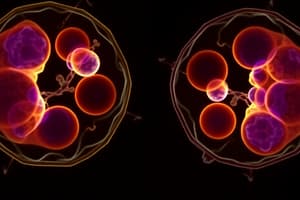Podcast
Questions and Answers
What primary function is associated with epithelial tissue?
What primary function is associated with epithelial tissue?
- Provides communication between nerve cells
- Regulates blood flow in vessels
- Protects, secretes, absorbs, and filters (correct)
- Facilitates contraction and movement
Which phase of mitosis is characterized by chromosomes lining up in the middle of the cell?
Which phase of mitosis is characterized by chromosomes lining up in the middle of the cell?
- Telophase
- Anaphase
- Metaphase (correct)
- Prophase
What is a key characteristic of simple squamous epithelium?
What is a key characteristic of simple squamous epithelium?
- Thick and cube-shaped cells
- Allows rapid diffusion due to its thinness (correct)
- Multiple layers of cells for strength
- Contains cilia for movement
In which phase of the cell cycle does DNA synthesis occur?
In which phase of the cell cycle does DNA synthesis occur?
Which type of connective tissue is associated with providing padding and insulation?
Which type of connective tissue is associated with providing padding and insulation?
What structure helps to pull sister chromatids apart during mitosis?
What structure helps to pull sister chromatids apart during mitosis?
Which epithelial tissue type is best suited for areas subjected to friction?
Which epithelial tissue type is best suited for areas subjected to friction?
What is the primary function of neurons within nervous tissue?
What is the primary function of neurons within nervous tissue?
Which type of muscle tissue is found in the walls of hollow organs?
Which type of muscle tissue is found in the walls of hollow organs?
Which epithelial tissue regenerates the fastest?
Which epithelial tissue regenerates the fastest?
What major event occurs during telophase?
What major event occurs during telophase?
What describes the apical surface of epithelial cells?
What describes the apical surface of epithelial cells?
Which characteristic defines stratified epithelia?
Which characteristic defines stratified epithelia?
What is the function of glial cells in nervous tissue?
What is the function of glial cells in nervous tissue?
Flashcards are hidden until you start studying
Study Notes
Interphase and Mitotic Phase
- Interphase consists of G1, S, and G2 phases and is the longest phase of the cell cycle.
- G1 phase involves cell growth and a restriction point determining if the cell will proceed to division.
- S phase includes DNA synthesis and further growth.
- G2 phase focuses on cell growth, final preparations for mitosis, and the presence of a checkpoint for DNA integrity.
- Each centriole has two centrioles, crucial for cell division.
Mitotic Phase (Mitosis)
- Prophase: Chromatin condenses into visible chromosomes; centrosomes organize microtubules; mitotic spindle forms, attaching to chromosomes composed of two chromatids.
- Metaphase: Chromosomes align at the metaphase plate; spindle fibers pull chromatids toward the center; centromeres connect sister chromatids.
- Anaphase: The shortest phase; mitotic spindle separates sister chromatids, pulling them towards opposite poles.
- Telophase/Cytokinesis: Nuclear envelope and nucleolus re-form; a contractile ring forms at the cleavage furrow, leading to cell division.
Tissue Types Overview
- Nervous Tissue: Essential for internal communication; composed of neurons that transmit signals and glial cells that support and protect neurons.
- Muscle Tissue: Responsible for movement; includes skeletal (attached to bones), cardiac (heart), and smooth (hollow organs) muscles.
- Epithelial Tissue: Covers surfaces, protects, secretes, absorbs, and filters. It's avascular, relies on connective tissue for blood supply, and consists of tightly packed cells.
- Connective Tissue: Provides support and structure; binds tissues together; includes tendons, bones, adipose tissue, and has an abundant extracellular matrix.
Epithelial Tissue Characteristics
- Lacks blood supply (avascular).
- Exhibits polarity with distinct basal and apical surfaces.
- Contains minimal extracellular matrix.
- Primarily composed of tightly packed cells with rapid regeneration capabilities.
Types of Epithelial Cells
- Simple Epithelium: One layer of cells; includes:
- Simple squamous: Flat; ideal for rapid diffusion; found in alveoli and blood vessels.
- Simple cuboidal: Cube-shaped; involved in secretion and absorption; located in kidney tubules.
- Simple columnar: Taller; contain goblet cells for mucus secretion; found in intestines, may have microvilli.
- Stratified Epithelium: Two or more layers; includes:
- Stratified squamous: Multiple layers; resistant to friction; found in mouth, vagina, and anus.
- Stratified cuboidal: Uncommon; consists of two layers of cube-shaped cells.
- Stratified columnar: Rare; consists of multiple layers of columnar cells.
- Transitional: Multiple layers that can change shape; located in the bladder.
Functions and Locations of Simple and Stratified Epithelia
- Simple Squamous Epithelium: Optimal for absorption, secretion, and diffusion; found in the alveoli and capillaries.
- Simple Cuboidal Epithelium: Functions in secretion and absorption; predominantly in kidneys.
- Simple Columnar Epithelium: Taller cells with potential for mucus secretion; found in digestive tract.
- Stratified Squamous Epithelium: Provides surface protection against friction; found in areas subjected to abrasion like oral cavity and vagina.
- Stratified Cuboidal/Columnar Epithelium: Rare; occasional locations primarily in glands.
Studying That Suits You
Use AI to generate personalized quizzes and flashcards to suit your learning preferences.




